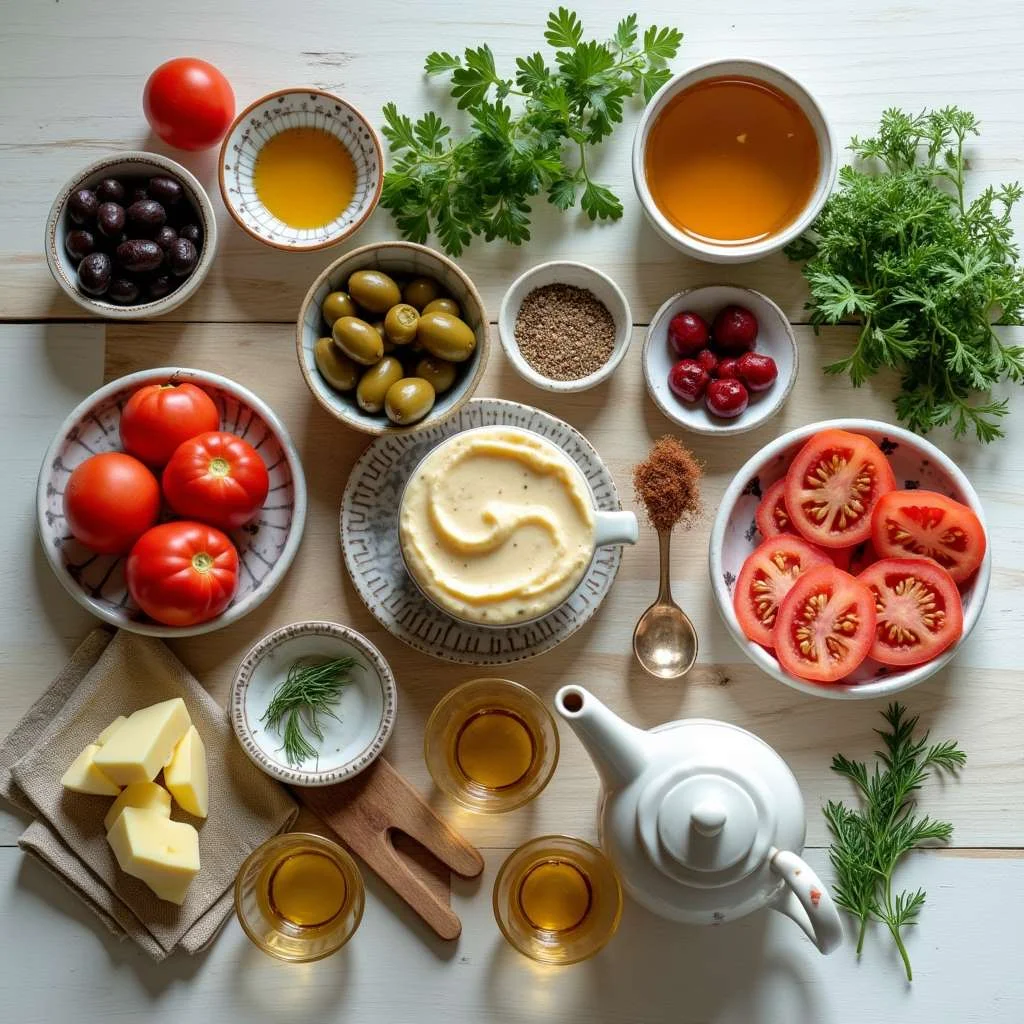What Makes Turkish Breakfast Food So Unique? Learn About Its Varieties
Are you tired of the same boring breakfast routine each morning? Turkish breakfast food offers a refreshing alternative that will transform your morning meal experience. This vibrant, diverse spread known as “kahvaltı” (literally meaning “before coffee”) delivers a symphony of flavors and textures that will delight your taste buds and energize your day. As someone who has studied Turkish cuisine for over a decade and spent years exploring the breakfast traditions across different regions of Turkey, I’ve discovered the secrets that make this morning ritual truly special.
In this comprehensive guide, you’ll discover what makes Turkish breakfast uniquely satisfying, from the essential components of a traditional spread to regional specialties. We’ll explore ingredient selection, preparation techniques, and serving suggestions to help you create an authentic Turkish breakfast experience at home.
Table of Contents
Why This Recipe Works
- Utilizes simple, fresh ingredients that are accessible in most grocery stores
- Offers incredible variety that satisfies every palate and dietary preference
- Creates a leisurely, social dining experience perfect for weekends with family and friends
- Balances nutrition with delicious flavors for a truly satisfying start to your day
- Adapts easily to different seasons and available ingredients
Choosing the Right Ingredients for Turkish Breakfast Food
Essential Bread Components
The cornerstone of any Turkish breakfast is bread. Simit, a circular bread covered in sesame seeds, offers a delightful crunch and nutty flavor. Alternatively, pide (Turkish flatbread) provides the perfect vessel for scooping up various spreads and dips. For an authentic experience, look for freshly baked bread with a crisp exterior and soft interior.
Cheese Varieties
Turkish breakfast features an impressive array of cheeses. Beyaz peynir (similar to feta) offers a tangy, salty flavor that complements sweeter elements. Kaşar cheese delivers a mild, slightly nutty taste comparable to young gouda. When selecting cheese, prioritize quality over quantity—a small portion of high-quality cheese contributes more flavor than larger amounts of inferior varieties.
Protein Components
Eggs prepared as menemen (scrambled with tomatoes and peppers) or simply boiled are staples on the Turkish breakfast table. Pastırma (air-dried cured beef) and sucuk (spicy sausage) add savory depth. For the best flavor experience, source pastırma from specialty markets where it’s properly aged and sliced to order.
Ingredients & Prep


Fresh Produce Essentials
- Tomatoes: Ripe, firm tomatoes sliced into wedges or diced for menemen
- Cucumbers: Persian or English varieties cut into half-moons
- Olives: Both black and green varieties, preferably brined rather than canned
- Fresh herbs: Parsley, mint, and dill add brightness and aroma
Spreads and Preserves
- Bal (honey): Ideally sourced from local producers or specialty markets
- Pekmez (grape molasses): Look for pure varieties without added sugars
- Tahin (tahini): Used both plain and mixed with pekmez for a sweet-savory spread
- Reçel (preserves): Traditional varieties include rose, sour cherry, and fig
Pantry Staples
- Turkish tea: The essential beverage served in small tulip-shaped glasses
- Butter: High-quality, preferably cultured butter for spreading on bread
- Olive oil: Extra virgin for drizzling over cheese and vegetables
- Za’atar or sumac: Sprinkled over eggs and vegetables for added depth
Step-by-Step Preparation Instructions
Pre-Breakfast Setup
Prepare Turkish breakfast as a communal spread where all components are served simultaneously on the table. Begin by arranging small plates and bowls for individual servings of different ingredients. Turkish breakfast is designed to be a leisurely experience, so allow ample time for both preparation and enjoyment.
Assembling the Breakfast Table
- Center larger serving plates with sliced vegetables, cheeses, and olives
- Arrange smaller dishes of preserves, honey, and other spreads around the center
- Place bread in a basket lined with a cloth to keep it warm
- Set out individual plates, small forks, and knives for each diner
Preparing Hot Components
- Brew Turkish tea in a double-teapot (çaydanlık) with water in the bottom pot and strong tea in the top
- Cook eggs just before serving, either as menemen or boiled to desired doneness
- If serving sucuk, slice thinly and sauté briefly until edges crisp and fat renders
Serving Style
Turkish breakfast is traditionally served family-style, with all dishes placed on the table simultaneously. Each person creates their own combinations by selecting from the diverse offerings. This style encourages conversation and a relaxed pace, which is central to the Turkish breakfast experience.
Pro Tips for Perfect Turkish Breakfast
Achieving Authentic Flavor
- Balance is key—offer a spectrum of flavors from salty (cheese, olives) to sweet (honey, preserves)
- Allow cheese to come to room temperature before serving for optimal flavor and texture
- Drizzle high-quality olive oil over white cheese for enhanced richness
- Serve tea in traditional tulip-shaped glasses filled only halfway to allow proper cooling
Common Mistakes to Avoid
- Rushing the experience—Turkish breakfast is meant to be enjoyed slowly
- Overcrowding your spread with too many options—quality over quantity
- Using store-bought, pre-sliced vegetables rather than fresh-cut produce
- Serving tea too weak or in the wrong vessels (small glasses are traditional)
Storage & Preparation Ahead
- Prepare cut vegetables and arrange cheese platters the night before, covered and refrigerated
- Set the table in advance to streamline morning preparations
- Store leftover components separately in airtight containers for up to 3 days
Regional Variations
Istanbul Style
- Features more refined ingredients including kaymak (clotted cream) with honey
- Often includes börek (flaky pastries filled with cheese or minced meat)
- Emphasizes delicate flavors and elegant presentation
Black Sea Region
- Incorporates corn bread (mısır ekmeği) instead of traditional wheat varieties
- Features local cheeses like Mihalic peyniri with distinctive flavor profiles
- Often includes hamsi (anchovy) dishes, especially in coastal areas
Eastern Anatolia
- Showcases Van herbed cheese (otlu peynir) studded with wild herbs and garlic
- Features heavier, more substantial components for colder climates
- Includes regional specialties like kavurma (preserved meat) and local honey varieties
Serving Suggestions
- Accompany with freshly squeezed orange or pomegranate juice for vitamin-rich refreshment
- Serve Turkish coffee as a finale to the breakfast rather than during the meal
- Create seasonal variations by incorporating fresh fruits like cherries in summer or oranges in winter
- For special occasions, include specialty pastries like açma (soft buttery rolls) or poğaça (savory filled buns)
FAQs
Can I prepare Turkish breakfast in advance?
While some components can be prepared ahead, Turkish breakfast is best enjoyed with freshly sliced produce and warm bread. Prepare what you can the night before, but save final assembly for the morning.
Is Turkish breakfast suitable for vegetarians?
Absolutely! Simply omit the meat components like sucuk and pastırma. The diverse selection of cheeses, vegetables, olives, honey, and preserves creates a satisfying vegetarian spread.
What’s the proper way to drink Turkish tea?
Turkish tea is traditionally served in small tulip-shaped glasses. Pour tea to fill about half the glass, allowing drinkers to adjust the strength by adding hot water from a separate pot. Sip slowly throughout the breakfast experience.
How can I recreate Turkish breakfast if I don’t have access to specialty ingredients?
Substitute feta for beyaz peynir, chorizo or dry salami for sucuk, and local honey and preserves. The spirit of Turkish breakfast lies in the communal experience and variety rather than specific brands or products.
Looking for more turkish ideas, reach the following:
- Turkish Breakfast Dishes: How to Create the Perfect Morning Spread
- Traditional Turkish Breakfast: Why It’s the Best Morning Meal
Conclusion
Turkish breakfast represents more than just a meal—it’s a celebration of community, fresh ingredients, and taking time to savor life’s simple pleasures. By bringing together a thoughtful selection of complementary flavors and textures, you create an experience that nourishes both body and soul.
How did you find our Post?
There are no reviews yet. Be the first one to write one.

